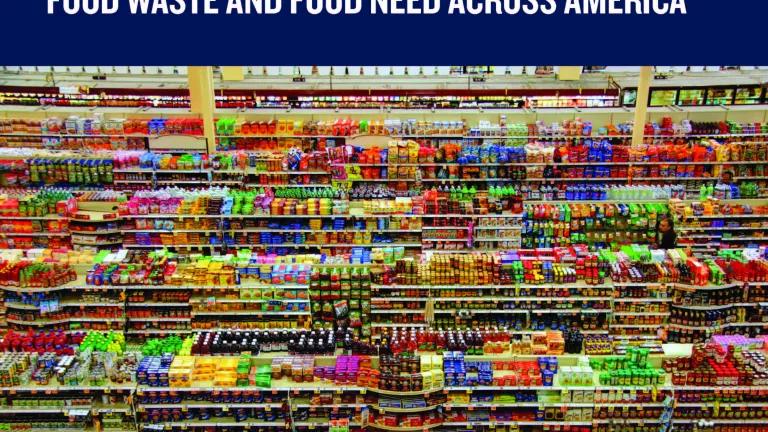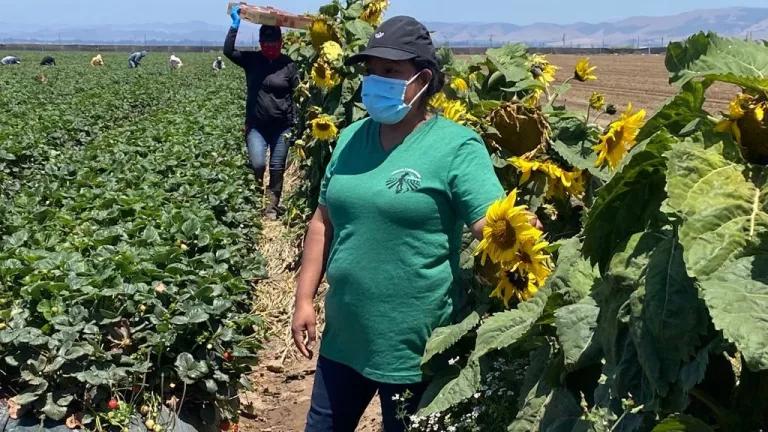States Can Leverage SNAP for Healthy Food & Strong Economies

Every family has the right to a healthy and varied diet, but in too many communities, fresh produce is not available or affordable. The federal Supplemental Nutrition Assistance Program (SNAP) already helps tens of millions of people access food. SNAP incentive programs, which increase the value of SNAP dollars when they are spent in specific ways, often on local produce, are a meaningful way for states to leverage federal dollars. As part of a package of policies that expand and strengthen SNAP in the face of the COVID-19 pandemic, incentive programs are a powerful way for states to improve the purchasing power of low-income consumers and increase the number of families incorporating healthy, fresh produce into their meals, all while benefiting regional economies by supporting local farmers.
Even before the COVID-19 crisis, more than 40 million people faced food insecurity, while small and sustainable farmers struggled to turn a profit and stay in business. Low-income communities, including food system workers at every stage of the food chain, bear the daily burdens of our food system and this longstanding reality has only been exacerbated by the pandemic.
Nearly 41 million people in the United States have filed for unemployment over the last ten weeks. With job losses especially acute among households that were earning $40,000 or less, for far too many of the newly unemployed, their families are struggling to afford necessities like food, medicine, rent, and utilities. At the same time, due to lost and shifting markets, farmers face mounting financial challenges as they attempt to protect themselves and their frontline workers, while still feeding the communities that depend on them.
The federal SNAP safety net is in need of improvements, and certainly, one important way to support low-income consumers struggling to feed their families is to expand and improve the federal program. At the same time, states have the opportunity to act affirmatively by investing in SNAP incentive programs and leveraging existing federal dollars to make sure their residents can meaningfully access sufficient and healthy food, while simultaneously supporting local farms, which are an essential part of a thriving regional economy.
First launched in New York City in 2005 as Health Bucks, SNAP incentive programs are an incredible tool for increasing the purchasing power of low-income families, helping people buy more healthy, local foods, expanding markets for small farms, and supporting regional economies by keeping SNAP dollars circulating locally. Often funded by federal and state grants in connection with philanthropy through non-profit organizations, at least one incentive program is available in nearly every state, and certain models, including Double Up Food Bucks, are widespread.
The first prominent benefit of SNAP incentive programs is that they increase the purchasing power of low-income families, for more and healthier food and also other essentials. Only 1 in 10 adults in the United States eat as many fruits and vegetables daily as recommended by the U.S. Department of Agriculture’s (USDA) dietary guidelines. For a variety of reasons, including cost and convenience, people in poverty are consuming less fresh produce. Strikingly, over the last four decades, the relative price of fruits and vegetables has increased 40 percent while processed foods have gone down 20 to 30 percent.
Although not a remedy for the systemic and disproportionate environmental burdens borne by low-income communities and people of color around the country, consistent access to affordable and culturally appropriate produce can play a role in improving community health and helping to prevent disease. According to the Harvard School of Public Health, a diet rich in fruits and vegetables can help lower blood pressure, reduce the risk of heart disease and stroke, and prevent some types of cancer.
SNAP incentive programs help people eat more fresh produce. A 2008 Massachusetts study found that SNAP users receiving incentives increased their fruit and vegetable consumption by 26 percent. National surveys conducted by the non-profit Wholesome Wave found that 90 percent of consumers participating in its SNAP incentive program reported increasing or greatly increasing how many fruits and vegetables they consumed - a success credited to making fresh produce more affordable. Further, by bolstering low-income consumers’ budgets for more healthy food, SNAP incentive programs can help free up household resources for other necessities like housing, transportation, and medical bills.
The second benefit is that SNAP incentive programs boost regional economies by supporting local farmers, who in turn keep profits circulating locally. In 2008, when New York’s Health Bucks incentive program expanded and shifted to an electronic benefits transfer (“EBT”) model similar to what’s used to disburse federal SNAP benefits, participating farmers markets received nearly double the average daily revenue from EBT dollars compared to markets that didn’t accept Health Bucks. According to Wholesome Wave, after a federal SNAP incentive grant program was established in 2014, and as a result of the increased purchasing power of SNAP recipients, farmers markets accepting SNAP saw a 30 percent increase in revenue when incentive programs were in effect. Early research in Michigan even found that SNAP recipients appeared to be spending more at farmers markets than just the combined value of the incentive and matched SNAP benefits.
These kinds of revenue increases are a lifeline for the small farms that sell at these markets. Though they reap less than five percent of farm income, small farms are responsible for 58 percent of direct-to-consumer sales, like at farmers markets and through farm shares. Soberingly, only 41 percent of small farms turn a profit each year and 64 percent of small farmers work a second job.
Leveraging SNAP dollars to support local food purchases benefits small farmers directly, while also keeping the money spent on their products circulating locally and in the state. In fact, two-thirds of money spent at farmers markets stays in the local economy, while 99 percent stays in the state. Research has found that every dollar spent at a farmers market can generate up to $2.80 in the local economy. This is sometimes referred to as the “multiplier effect,” a term to describe the amount of economic activity triggered by the purchase of any one item as the dollars circulate in the local economy.

SNAP incentive programs can increase the purchasing power of low-income shoppers and remove barriers to purchasing more fruits and vegetables, while simultaneously bolstering regional economies by supporting local farmers. To achieve these dual policy goals, states should (1) maximize SNAP enrollment in their states; (2) increase funds available for SNAP incentive programs; and (3) make these incentive programs more flexible and easier to use.
1. States should ensure they are maximizing federal benefits available to their residents.
Ensure robust enrollment among SNAP-eligible households
Even as states invest in their SNAP incentive programs, they should also ensure that all eligible persons are enrolled in SNAP. Nationally, about 85 percent of people who qualify for SNAP receive benefits, while households with earned income and seniors have the lowest levels of enrollment.
Enrollment numbers among eligible households vary drastically by state, with some reporting 100 percent enrollment while Arkansas, Arizona, California, North Dakota, Texas, Utah, and Wyoming have consistently low participation relative to other places. Maximizing SNAP enrollment is an essential step to make sure low-income families can afford enough food and increase the number of residents eligible to access important SNAP incentive programs.
Implement a Pandemic-EBT program to help families with children who are losing meals during school closures
States can apply to USDA to establish a Pandemic-EBT (P-EBT) program, which provides SNAP-like funding for families with children who are no longer receiving free or reduced-price school meals due to closures. In the contiguous United States, this benefit amounts to $114 per child every four weeks.
In states that have been approved for P-EBT, families with children unable to attend school because of COVID-19 and who already receive SNAP benefits have the additional funds automatically added to their EBT cards. For families not already receiving SNAP, new cards are issued to distribute their P-EBT benefits.
USDA approval of P-EBT has been slow and some states have struggled to distribute benefits, but this program remains critical for families in need. Importantly, it can also be leveraged for SNAP incentive programs. In fact, the Fair Food Network notes that P-EBT benefits are treated just like SNAP benefits for purposes of the Double Up Food Bucks incentive program.
2. States should increase their investment in SNAP incentives to fully leverage federal funds.
Secure adequate funding for incentive programs as overall SNAP enrollment rises
One of the most powerful features of SNAP is that the program is designed to grow and contract alongside national shifts in poverty and related household food insecurity. SNAP incentive programs, in contrast, are often supported through a combination of federal, state, or local funds and philanthropic grants, which are not equipped to expand alongside SNAP enrollment in response to moments of crisis.
In order to provide as many incentive dollars as SNAP recipients are able to redeem both during and after the COVID-19 pandemic, states should increase the funds allocated to these powerful incentive programs and apply for federal SNAP incentive funding from the USDA’s Gus Schumacher Nutrition Incentive Program, formerly known as the Food Insecurity Nutrition Incentive grant program.
Provide a one-to-one match of incentive dollars to SNAP benefits
SNAP incentive programs offering a full 1:1 match - meaning every $1 spent in SNAP benefits earns $1 in incentives - provide the greatest increase in the purchasing power of SNAP shoppers. With affordability identified as a major barrier to fruit and vegetable purchases, a full matching program means more and healthier food for consumers and increased revenue for farmers. For example, a Rhode Island study found that a 1:1 match was associated with a 211 percent increase in fruit and vegetable consumption among SNAP shoppers, while a lesser 1:2 match was associated with a 130 percent increase.
States with SNAP incentive programs that offer less than a 1:1 match should increase their incentives to avail themselves of the full public health and economic benefits of these programs.
3. States should increase the flexibility of their incentive programs, enabling SNAP recipients to shop safely and support the local economy.
Allow SNAP incentive program dollars to be used for fresh, local produce in retail stores and online grocers
Avenues to purchase fresh, local food have grown substantially in the last decade. Farmers markets remain important community hubs and critical sources of local food, but they are not the only or primary place people shop. In fact, for many SNAP recipients, there are barriers to shopping at farmers market that are not fully addressed by incentive programs, including the location of the markets and lack of transportation, cultural or language barriers, inconvenient hours, and the inability to buy all their groceries in one place.
Just as more affluent shoppers seek fresh, local food at the grocery store, through a community supported agriculture membership, or even through online farm sales, SNAP recipients should have the same variety of opportunities for their incentive dollars. In fact, more than 95 percent of SNAP spending takes place in traditional retail stores, meaning corner markets, grocery stores, and supermarkets, so shoppers’ access to incentive benefits at these same locations is key.
Further, increasing the number of places where SNAP recipients can use their spending power will better support local businesses. For example, a locally-owned grocery chain in Kansas City, Missouri saw a 15 percent increase in local produce sales after the store began offering Double Up Food Bucks.
This flexibility is especially important during the COVID-19 crisis as consumers shift their habits, including toward increased online shopping, to better protect themselves and their families. Especially for seniors and those with pre-existing health conditions, making it safe and easy for low-income consumers to maximize their purchasing power and buy healthy, local foods is essential.
Allow SNAP incentive program dollars to be used for locally-produced shelf stable items, known as “value-added” products
In some states, SNAP incentive dollars can only be used to purchase whole fruits and vegetables, which limits SNAP shoppers from purchasing local foods that have been processed into shelf stable items that are commonly sold at farmers markets, including flour, salsa, and jam. States should expand their SNAP incentive programs to include locally grown and produced items that are part of a healthy and varied diet. This improvement to SNAP incentive programs is especially important now as communities seek to limit shopping trips and buy foods that will keep longer during the COVID-19 pandemic.
In addition to broadening the choices available to SNAP recipients, these shelf stable products are an important way to expand the market for farmers and other small businesses committed to using locally-grown products and building local processing capacity. Crucially, benefits to farmers of selling value-added products include an extended farming season, improved cash flow to the farm, and employee retention.
Value-added products also further enhance the “multiplier effect” of small farms. Utah State University found the multiplier effect of value-added products to be between 1.79 and 2.31 - in other words, every $100,000 spent on raw farm ingredients for processing could be expected to generate more than $175,000 for the Utah economy.
SNAP incentive programs are well-studied tools for expanding the purchasing power of low-income consumers, increasing fruit and vegetable consumption, improving the viability of small farms, and supporting local economic development. In response to the COVID-19 pandemic and its associated economic downturn, states should invest in these powerful programs and seize the opportunity to harness federal SNAP dollars.




